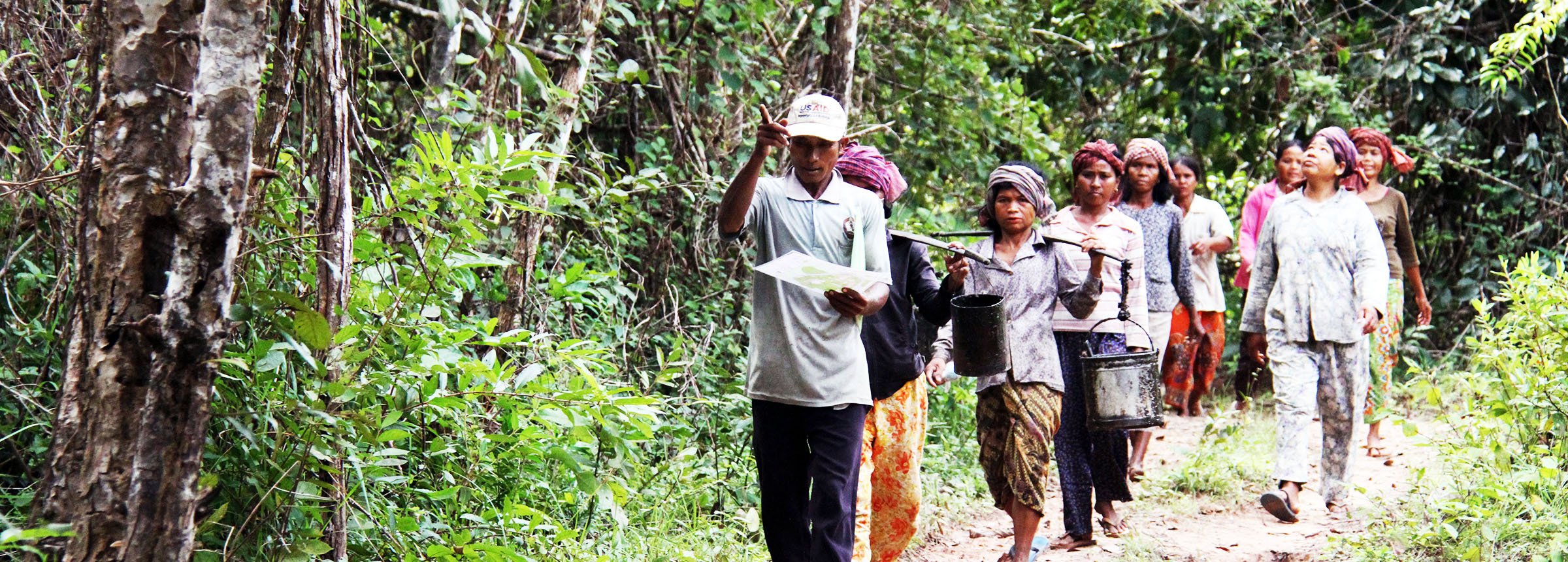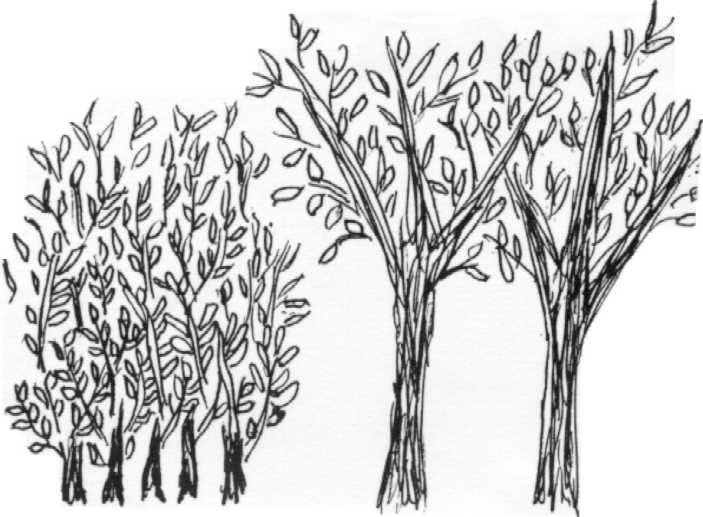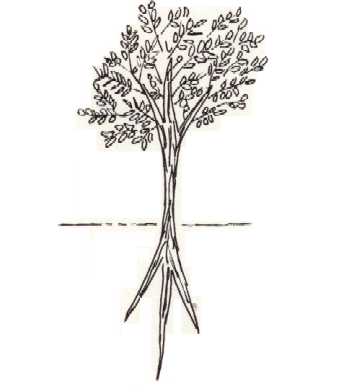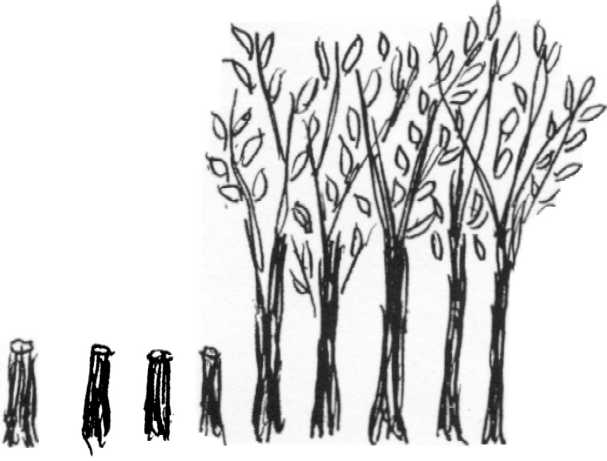
Fodder bank establishment and management
Agroforestry for the Pacific Technologies
A publication of the Agroforestry Information Service
April 1994, Number 8
Fodder Bank Establishment and Management
Livestock play an important role in most small scale farming systems throughout the world. They provide traction to plow fields, manure which maintains crop productivity, and nutritious food products for human consumption. In most small scale farming systems livestock graze in pastures or woodlands feeding on grass and other herbaceous plants. During the wet season these lands provide adequate forage to maintain productive animals. In the dry season however, the quantity and quality of forage greatly decreases and is generally low in nutritional value. Livestock sustained on such diets often lose weight and productivity.
To avoid this problem farmers must provide their animals with quality feeds to augment dry season forages. One option is to supply expensive concentrates or supplemental feeding. For most small scale farmers this is not possible due to high costs and limited availability of supplements. A more practical option is for farmers to establish fodder banks. Fodder banks are plantings of high-quality fodder species. Their goal is to maintain healthy productive animals. They can be utilized all year, but are designed to bridge the forage scarcity of annual dry seasons. Fodder banks do not provide 100% of feed requirements, but supplement the available dry season forage.
Fodder bank plants are usually trees or shrubs, and often legumes. The relatively deep roots of these woody perennials allow them to reach soil nutrients and moisture not available to grasses and herbaceous plants. This characteristic enables these plants to retain fresh foliage into the dry season. The ability of some legumes to fix atmospheric nitrogen makes them protein rich feeds.
ESTABLISHMENT
Fodder banks are valuable crops which support productive farming systems. They should be managed intensively. Thorough site preparation is necessary to establish fodder banks. This can be accomplished by mechanical or chemical means. Use methods practiced locally for other high value crops. The goal is a weedier seed bed, in which plant growth and survival will be maximized. As with all tree planting activities fodder bank establishment must coincide with the rainy season. This assures high plant survival.
Planting material. Direct seeding is normally recommended for fodder bank establishment. Seeds of many fodder bank species must be soaked in water or scarified to assure good germination. Information on these methods is available through the AIS-NFTA office. Sowing depth depends on seed and site characteristics. Most seeds should be sown at a depth equal to 1-2 times their width. In heavy soils, or when seed is small, sowing depth should be shallow. In arid and semi-arid environments sowing depth should be deep. For most seed types, successful sowing methods vary from place to place. Use those methods practiced locally for a similar type of seed.
Fodder bank establishment is also possible with seedlings or cuttings. However, because of the large number of plants needed this is often impractical. When seedlings or cuttings are used wide plant spacing, 50×50 cm or 1×1 meter, is usually recommended. Species that can be established by cuttings include Gliricidia sepium and Erythrina spp.
Post-establishment care Although most fodder bank species are considered fast-growing their initial growth is often slow. During this period seedlings are susceptible to weed competition for light, moisture and soil nutrients. Depending on weed growth, the fodder bank should be thoroughly weeded every 2-4 weeks. This level of weed, control should be maintained until the fodder bank species achieve a dominant canopy position and begin to suppress weed growth. This usually occurs six months after establishment.
The use of fertilizers to improve fodder bank establishment is not generally recommended. Fertilizers are expensive, and if available may be better utilized for food crop production. Fertilizer requirements of many fodder bank species are not well documented. When fertilizers are used, they must be accompanied with thorough weed control. Fertilization without adequate weed control results in decreased survival and growth of fodder bank species.
SPACING AND DESIGN
To maximize dry season production, fodder banks should be dense, nearly pure stands. Recommended spacings vary from 5×5 cm. to 1×1 m. Choice of spacing depends on management objectives. Total biomass yields per area increase at higher densities. Wider spacing are generally used when both fodder and small diameter wood, for fuel or poles, are desired. Closer spacing maximizes fodder production, but may make access for harvest or grazing difficult. Spacing of 1×1 meter is common for many species.

Fodder production and accessibility can be improved by using double rows of fodder trees at wider spacing. Rows are established about 50 cm apart with 1-1.5 meters between double rows. In row spacing of trees varies from 5-50 cm. Ideally, rows are oriented along the contours in an east-west direction. This orientation provides optimum fodder bank sun exposure and erosion control. Of course this is not always possible. Row establishment should conform to site geography. When the slope is steep, it is best to establish rows along the contours. Control of soil erosion improves with closer in-rows spacing.
Once the fodder bank is well established, grass should be allowed to grow in the area between double rows. Competition between bank trees and grass will not be as severe as during the establishment period. Tree roots will feed from deep in the soil, grass from near the surface. Their difference in height will also decrease competition for sunlight. This two-tiered system produces more fodder per area than either plant type alone. The grass grown in the interrow area should be an excellent fodder species. Competition between trees and grass should be monitored constantly so that fodder bank productivity does not decrease. The natural establishment of poor quality fodder grasses should be closely controlled.
Researchers in Bali, Indonesia have designed a Three Strata Forage System (TSFS) which contains full sized trees, trees maintained as hedges and grasses. Respectively, the components produce fodder for the late dry season, middle dry season and the wet season. Tree spacing is five meters, hedge species spacing 10 cm and grass planted the entire length and width. The TSFS is planted in five meters wide strips around crop land (Nitis et al. 1987).
MANAGEMENT
Age at first harvest. In most circumstances the first harvest should be delayed until the bank is 9-21 months old. Actual age at first harvest depends on environmental conditions and bank growth. Under arid or poor soil conditions growth will be slow and the first harvest should be later. When growth is fast, the first harvest may be sooner. The goal is to allow fodder bank species to establish deep roots and thick trunk diameters. The resultant healthy plans have ample carbohydrate reserves and respond well to harvesting. Biomass production/harvest and long-term production both increase when the first harvest is delayed. It is believed that the first harvest, whether from cutting or grazing, terminates the downward growth of taproots. This is an important consideration in arid and semi-arid environments.

Grazing. Fodder banks can be directly grazed by livestock. This system saves labor and effort but can Mad to plant damage and fodder waste from trampling. The key to direct grazing is subdivision of the fodder bank into paddocks. Livestock should be restricted to one paddock until the available fodder resource is fully utilized. Animals should then be moved to the next paddock.
If environmental and plant growth conditions are favorable, fodder banks may be grazed year-round. Grazing periods are generally 1-2 weeks, followed by recuperation periods of 3-6 week (or three times the grazing period). Under arid conditions the recuperation period may need to be longer. To stimulate tree growth fodder banks should be cut to a uniform height after the grazing period. Cutting height is discussed in more detail below.
With most species complete defoliation during the grazing period is permissible, as long as cutting and grazing are excluded during recuperation. To assure adequate recuperation, paddocks should be fenced or protected in a similar manner. After long recuperation periods tree height may make fodder inaccessible to animals. This is often a problem when fodder banks are not grazed all year. Periodic cutting of sections of each paddock may be necessary to improve animal access. The cut fodder is left on the ground where livestock can access it. The area cut should correspond to what will be eaten before the next cutting.
Goats and sheep often eat the bark as well as leaves of fodder trees. This can lead to tree mortality and decreased long-term fodder bank productivity. Unless closely monitored, goats and sheep should not be allowed to graze fodder banks. Cattle generally do not cause this problem.
Cut-and-carry. Most fodder banks are managed through a cut-and-carry system in which the fodder is harvested and then ‘carried’ to the livestock. The animals may be a great distance from the fodder bank or just across a protective fence. Special harvesting equipment is available for fodder banks but all that is necessary is a sharp machete. A cut-and-carry system decreases fodder waste from animal damage and the necessity to monitor animals. However, labor inputs may be greater than with direct grazing systems.
Important management factors to consider for a cut-and-carry system are cutting height, cutting frequency, and dry season management. These factors are all influenced by precipitation, temperature, soils, species, plant spacing, as well as each other. Interactions are unique for each situation, resulting in effective management prescriptions that differ at each site. However, general recommendations are possible for each management factor. Farmers and managers should refine these recommendations to determine the best management prescription for their specific situation.
Cutting height. To obtain maximum fodder production research studies have recommend a great variety of cutting heights. Review of these results suggest a standard cutting height of 50-150 cm. Besides fodder production this height provides other advantage Trees retain adequate foliage to ensure rapid regrowth and plant longevity. Fodder is harvested with a minimum of bending or reaching, allowing for efficient movement by the harvester.

A notable exception to the standard recommendation is the management of Sesbania grandiflora. This species experiences a high degree of mortality when its main stem is cut. Side branches can be harvested, but it should not be completely defoliated or have its main stem pruned below 150 cm.
After 2-3 years of production it is recommended to cut Leucaena back to 25 cm. This lower height removes much of the dead wood and rejuvenates foliage production. This may be true for other species also. However, regular cutting below 50 cm may cause increased mortality and decreased long-term productivity.
Cutting frequency. As with cutting height research studies have recommended a great variety of cutting frequencies. The most common cutting frequencies are 6-18 weeks. Generally, longer cutting frequencies, 12-18 weeks, generate more total biomass but increase the proportion of small wood production. Shorter cutting frequencies, 6-12 weeks, favor fodder yields and fodder quality. Younger foliage tends to have a higher nutritive value and palatability. However, repeated cutting after short frequencies decrease longevity.
Standard cutting frequencies were developed for tropical conditions and tend to correlate with regrowth heights of 1-2.5 meters. Under arid, sub-humid or temperate conditions regrowth may take longer to reach this height, cutting frequencies may need to be extended.
Dry-season management. Dry-season fodder production is a main objective of fodder bank management. In areas with severe dry-seasons special management practices should be followed. Six to eight weeks before the beginning of the dry-season trees should be cut to the recommended height. The new foliage produced over the next few weeks will be retained well into the dry-season when it is most needed. Left uncut for 4-6 months, Gliricidia sepium will not retain its leaves into the dry-season. This may be true for other species as well.
When the dry-season is very long or the area of fodder bank very large, the pre-dry-season harvest should occur in phases. This will assure that fodder is available throughout the dry-season. During these pre-dry-season harvests the amount of fodder available may exceed normal needs. The excess may be used to increase animal rations, make silage for dry-season use, or mulch crops. Dry-season regrowth will be slow, and cutting frequencies may need to be extended.
Fertilization. Fodder banks are long-term crops that must be properly maintained to continue high productivity. Even under direct grazing, fodder banks remove large amounts of soil nutrients from the site. These nutrients must be replenished by application of manures or chemical fertilizers. As previously mentioned, little is known of the nutrient requirements of most fodder bank species. However, as with most crops, nitrogen, phosphorus and potassium are important nutrients. Application for these and other nutrients should be determined locally. Availability and costs of fertilizers may restrict their use. The nitrogen requirement may be self-provided if the species used are nitrogen-fixing.
Species. Many species make excellent fodder bank components. In general these species:
- establish readily
- grow fast
- out-compete weeds
- produce high-quality fodder
- remain productive under repeated harvest
- remain productive during dry seasons
- survive on poor sites
A list of recommended fodder bank species and their respective ecological zones appear in Table 1.
Table 1. Fodder bank species and their ecological zones.
|
Arid & Semi-arid Tropics Albizia lebbeck Cajanus cajan Sesbania sesban |
Humid Tropic Acacia angustissima Albizia lebbeck Cajanus cajan Calliandra calothyrsus Calliandra tetragona Desmodium spp. Erythrina berteroana Erythrina poeppigiana Flemingia macrophylla Gliricidia sepium Leuceana leucocephala Leuceana diversifolia Sesbania grandiflora Sesbania sesban |
Highland tropics Calliandra calothyrsus Calliandra tetragona Erythrina arborescens Erythrina buranas Erythrina edulis Sesbania sesban Leuceana diversifolia |
Arid & Semi-arid Temperate Chamaecytisus palmensis |
Further reading
Brewbaker, J.L, K. MacDicken, and D. Withington (editors) 1989. Leucaena forage production and use. Nitrogen Fixing Tree Association. Paia, Hawaii, USA. 39 p.
Devendra, C. (editor) 1990. Shrubs and Tree Fodders for Farm Animals. International Development Research Centre. Ottawa, Ontario, Canada. 349 p.
Evans, D.O. and B. Macklin (editors) 1990. Perennial Sesbania production and use. Nitrogen Fixing Tree Association. Paia, Hawaii, USA 41 p.
Glover. N. (editor) 1989. Gliricidia production and use. Nitrogen Fixing Tree Association. Paia, Hawaii, USA. 44p.
Ivory, DA 1990. Major characteristics, agronomic features, and nutritional values of shrubs and tree fodders. pp 22-38 in: C. Devendra (editor) Shrubs and Tree Fodders for Farm Animals. International Development Research Centre. Ottawa, Ontario, Canada. 349 D.
Krecik, S.G., D.O. Lantagne, M.A. Gold, and J.M. Roshetko. 1993. Cutting management of Leucaena, Calliandra calothyrsus and Gliricidia sepium for fodder production. Nitrogen Fixing Tree Research Reports 11:18-21.
Nitis, I.M., K. Lana, M. Suarna, W. Sukanten, and S. Putra. 1987. Growth and yield of Gliricidia sepium in association with grass, ground legumes and trees. pp 205-216. In: Withington, Glover, and Brewbaker (editors) Gliricidia sepium: Management and Improvement. Nitrogen Fixing Tree Association Special Publication 87-01. 225 p.
Paterson, R.T., G.A. Proverbs, and J.M. Keoghan. 1987. The management and use of forage banks. Caribbean Agricultural Research and Development Institute. St. Augustine, Trinidad, West Indies. 21 p.
Powell, M.H. and S.B. Westley (editors) 1993. Erythrina production and use. Nitrogen Fixing Tree Association. Paia, Hawaii, USA. 56 p.
Written by James Roshetko, Program Director for Asia, NFTA
Published by the Agroforestry Information Service (AIS) of the Nitrogen Fixing Tree Association (NFTA)
1010 Holomua Road, Paia, Hawaii 96779 USA Ph: (808) 579-9568 Fax (808) 579-8516
A publication of the Forest, Farm, and Community Tree Network (FACT Net)
Winrock International
Email: forestry@msmail.winrock.org
